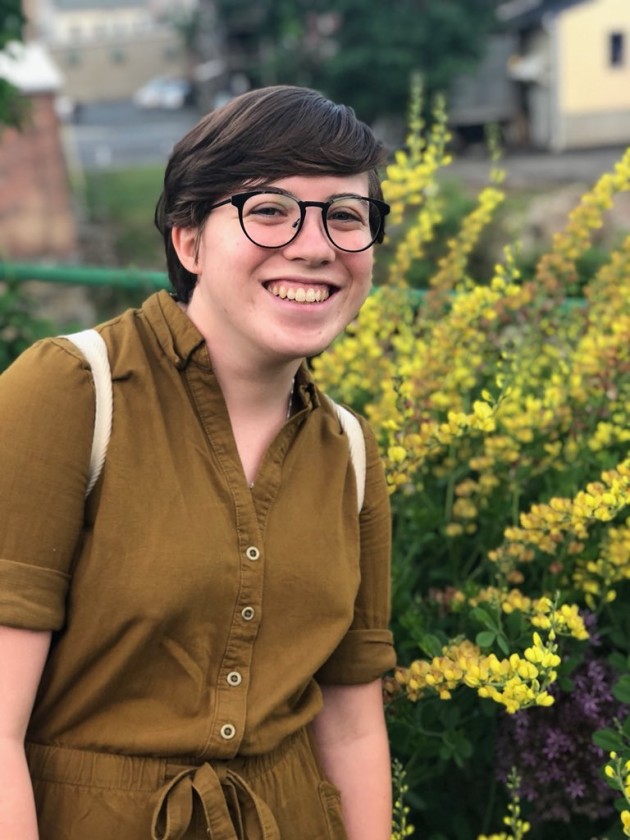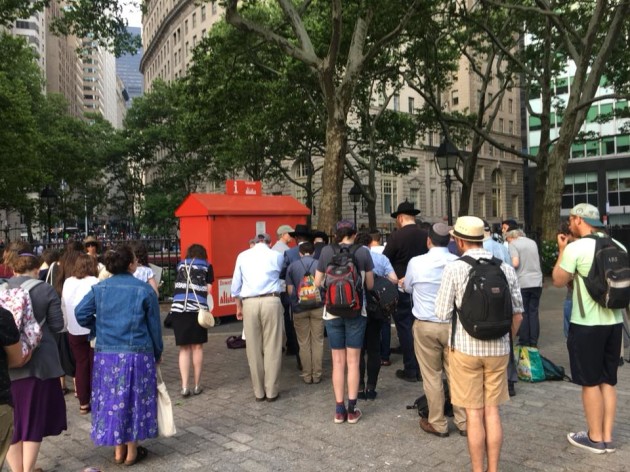The Lilith Blog
July 17, 2018 by admin
Submit to Lilith’s Fiction Contest!
Lilith Magazine—independent, Jewish and frankly feminist—invites submissions of quality short fiction, 3,000 words or under, for our Annual Fiction Contest. When selecting what you’ll submit, please remember our tagline.
The magazine proudly spotlights both emerging and established writers. Winner receives $250 + publication. Deadline: 9/30/18. Put “Fiction Contest Submission” as subject line and send to info@Lilith.org.
- 13 Comments
July 11, 2018 by Eleanor J. Bader
An Artist Who Welds Jewelry, Glass and Performance Together

As a little girl growing up on the outskirts of Durham, North Carolina, multidisciplinary artist Rachel Rader loved hearing—and eventually reading—all kinds of stories. She was especially fascinated by biblical narratives—she found the details of the flood myth and Noah’s creation of an ark particularly compelling. By the time she enrolled in Virginia Commonwealth University (VCU) in 2002, the Material Studies major decided to minor in Comparative Religion.
“I grew up going to a Conservative temple and always wondered what it meant that some people took biblical stories literally,” she begins. “Lately, I’ve been researching how myths repeat around the world, how they’re interpreted and presented by different cultures and religions, how they align and differ. That’s the inspiration behind my current effort, Ancient Truth Investigators, an ongoing, multi-dimensional art project that incorporates performance, sculpture, jewelry, and other materials.”
- No Comments
July 9, 2018 by Chanel Dubofsky
Four Things Rabbis Should Stop Saying at Weddings
Here we are, in the grip of another Wedding Season. Perhaps you’re a perpetual bridesmaid, or the one getting married, or you’re not particularly into marriage as a life choice for yourself.
Maybe you’re going to a wedding every weekend until the end of time (or Labor Day). As we descend further into the madness of tulle, plus-ones, and open bars, let’s review some things you’re basically guaranteed to find at Jewish weddings: aggressive dancing (ask me about incurring my stiletto related injury), which usually involves the couple being hoisted into the air on chairs while they pretend not to be afraid of falling, people shouting “Mazel Tov!,” and of course, a rabbi.
- 5 Comments
July 5, 2018 by Amy Stone
Muslim and Jewish Women on a Southern Civil Rights Road Trip

Reaching across the aisle – Cyndy Wyatt (left) and Dorene Alama discovered they
both attended the same Catholic school in upstate New York. Cyndy, now living in
Stowe, Vt., converted to Judaism. Dorene, in Charlotte, N.C., converted to Islam.
Photo: Amy Stone
Back in April, a busload of white and brown Jewish and Muslim women, some in hijab, headed south along the civil rights trail from Georgia to Alabama to Tennessee. What could go wrong?
We’re riding with Brenda, a third-generation female bus driver from Asheville, North Carolina, and Todd, our African-American civil rights expert. We’re a world away from the 1961 Freedom Riders aboard Greyhound buses attacked by violent mobs for attempting to integrate southern bus terminals. But this is also far from a Disneyland outing. We’re in the Trump era of hate with his Muslim ban and war on immigrants.
- No Comments
July 2, 2018 by admin
A Novel of Barren Island, NYC’s Forgotten Glue Factory
Told from the point-of-view of Marta Eisenstein Lane on the occasion of her 80th birthday, Carol Zoref’s novel Barren Island is the story of a long-forgotten factory island in New York’s Jamaica Bay, where the city’s dead horses and other large animals were rendered into glue and fertilizer from the mid-19th century until the 1930’s. The island itself is as central to the novel as the members of the Jewish, Greek, Italian, Irish, and African-American factory families that inhabit it, including those who live their entire lives steeped in the smell of rotting and burning animal flesh.
The story begins with the arrival of the Eisenstein family, immigrants from Eastern Europe, and explores how the political and social upheavals of the 1930’s affect them and their neighbors in the years between the stock market crash of October 1929 and the start of World War II. Labor strife, union riots, the New Deal, the World’s Fair, and the struggle to save European Jews from the growing threat of Nazi terror inform this novel as much as the explosion of civil and social liberties between the two World Wars.
- No Comments
June 29, 2018 by Kira Yates
Six Young, LGBTQ+ Jews Get Real About Identity
As Pride Month comes to an end, we asked six Jews who are also in the LGBTQIA+ community to speak about the interactions among their many identities. It is daunting to describe your identity in a few words, but the people featured below have done so with radical frankness —telling stories of coming out, coming to terms with identity, and joining together as a community, all of which define their lives Jewish, as LGBTQIA+, and at the intersections between the two.

Rochelle, 22
I feel as though being Jewish prepared me for being queer. When I was a small child, I learned how to move through the world with my Jewish identity always present but semi-hidden, and how to gauge when was a safe time to reveal it. I hold my lesbian identity very similarly, though recently I have been struggling to find ways to make both more visible.
- 1 Comment
June 28, 2018 by Chanel Dubofsky
If You’re Scared About “Roe” Today, Welcome to the Struggle
Yesterday’s bombshell news that Justice Anthony Kennedy—a reliable pro-abortion rights vote—is retiring from the Supreme Court means that Roe v. Wade is truly, seriously imperiled. We could wake up within a few years to find abortion fully illegal in over 20 states.
Ironically, in recent months, right up until the Kennedy-related outpouring of fear we’re seeing at this very moment began, abortion rights advocates had noticed a growing fatigue around the issue. Buzzfeed published an opinion piece by John Paul Rollert called Trump’s Power Isn’t Fear. It’s Fatigue. The relentlessness of this administration’s violence, its undoing of and disregard for human rights, and its intolerance and attacks on for science, logic,and journalism have left a lot of us with a sense that exhaustion—you might call it outrage fatigue.
- 2 Comments
June 27, 2018 by Rebecca Krevat
Why We’re Protesting the Orthodox Union Every Monday
 Keeping Kashrut, or kosher, is one of the most central and recognizable pillars of observant Judaism. As a child in a traditional but modern Orthodox community, I was taught the importance of keeping kosher. Even when I was a toddler, I asked my Orthodox uncle if his house was kosher before feeling comfortable eating there. For our family, food products needed kosher symbols. At the grocery store, families like ours all across the country scan products for the “OU” symbol from the Orthodox Union—one of the most widely recognized and trustworthy of the kosher symbols.
Keeping Kashrut, or kosher, is one of the most central and recognizable pillars of observant Judaism. As a child in a traditional but modern Orthodox community, I was taught the importance of keeping kosher. Even when I was a toddler, I asked my Orthodox uncle if his house was kosher before feeling comfortable eating there. For our family, food products needed kosher symbols. At the grocery store, families like ours all across the country scan products for the “OU” symbol from the Orthodox Union—one of the most widely recognized and trustworthy of the kosher symbols.
The Orthodox Union is an umbrella organization representing Orthodox synagogues and communities across the United States. In addition to telling the community what foods are permissible to eat, the OU runs programs that keeps the organization deeply rooted in Orthodox communities, including youth groups and support on campus. The OU is a significant component of the blood in the veins of the Orthodox communal world.
I didn’t even realize the OU did any political work outside of their communal support until 2014, when I noticed that they had commended the Supreme Court’s decision siding with Hobby Lobby in a notorious case regarding an employer’s responsibility to provide insurance inclusive of contraception, as mandated by the Affordable Care Act. They sided with the evangelical Christian plaintiffs in that case, even though President Obama had already ensured that any company that was not comfortable paying for contraception could employ a provision so the government would pay for it instead.
- No Comments
June 26, 2018 by Sharrona Pearl
If “Incivility” Makes You Sympathize with Racism, You Were Racist Already
When I was an undergrad, I sat on my Women’s Center Collective. We made decisions by consensus. All it took was one person to block something and it wouldn’t happen. So it took a while for things to happen. We had to talk about everything. And it could be super frustrating when something you cared about died in process because of the deeply held convictions (or intransigence) of some who maybe didn’t even totally understand the issue.
God, it was annoying. God, were we annoying. Believe me when I say that I fantasized more than once about a (benevolent, run by me) dictatorship of liberal ideals. Think about how much we (ahem, I) could get done! Imagine how quickly we could organize if we weren’t so minutely attuned to what might cause offense to…someone. Anyone.
- No Comments
June 24, 2018 by Eleanor J. Bader
A Bold Photographer Who Captures Social Justice Movements
For as long as she can remember, photojournalist Natalie Keyssar has been interested in the causes and casualties of violence and civic unrest. But it took years for her to muster the courage to pursue this particular angle; first, she covered metropolitan news and youth culture for the Wall Street Journal and a wide array of online and print outlets. Over her career, she has covered major neo-Nazi rallies, Kosher soup kitchens, tragic accidents and Occupy protests.
As the International Center of Photography’s Infinity Emerging Photographer Award winner, her eclectic work now appears regularly in Time, Bloomberg Business Week, the New York Times newspaper and magazine, and California Sunday, and has won plaudits not only from the ICP, but from the Aaron Siskind Foundation, PDN30, The Pulitzer Center, and the International Women’s Media Foundation.
Nailing 33-year-old Keyssar down for an interview took months—she is on the road for much of the year—but she and reporter Eleanor J. Bader recently met at a Brooklyn café where they spent several hours talking about Keyssar’s career, its unlikely trajectory, and her interest in covering movements for social justice at home and abroad.
- No Comments
 Please wait...
Please wait...